Website www.marchforlife.org | Start date 1974 | |
 | ||
Location Washington, D.C., United States | ||
Full speech kellyanne conway march for life 2017 washington dc
The March for Life is an annual rally protesting abortion, held in Washington, D.C., on or around the anniversary of the United States Supreme Court's decision legalizing abortion in the case Roe v. Wade. The march, whose stated mission is "to provide all Americans with a place to testify to the beauty of life and the dignity of each human person", advocates in overturning Roe v. Wade. It is organized by the March for Life Education and Defense Fund.
Contents
- Full speech kellyanne conway march for life 2017 washington dc
- Watch vice president mike pence speech march for life 2017 washington dc
- History
- Itinerary
- Attendance
- Notable speakers
- Media attention
- Associated events
- Anglican events
- Catholic events
- Eastern Orthodox events
- Evangelical events
- Lutheran events
- Virtual March for Life
- References
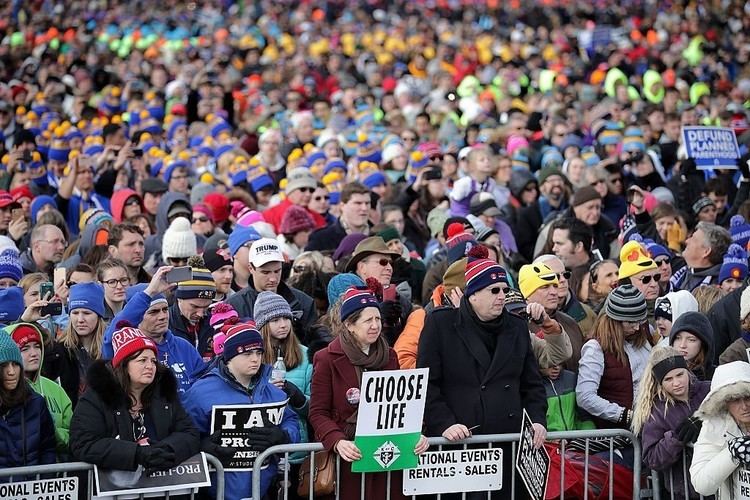
The 44th march was held on January 27, 2017 instead of the usual January 22, a week following the inauguration of President Donald Trump.

Watch vice president mike pence speech march for life 2017 washington dc
History
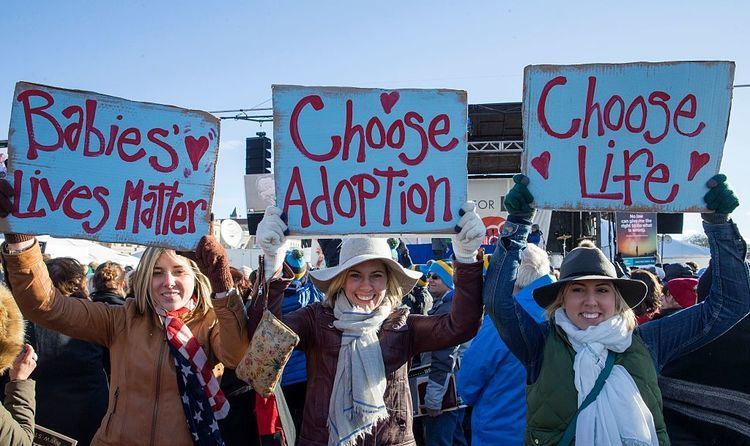
The first March for Life, which was founded by Nellie Gray, was held on January 22, 1974, on the West Steps of the Capitol, with an estimated 20,000 supporters in attendance. The march was originally intended to be a one-time event, in hopes that the United States Supreme Court would reverse Roe v. Wade immediately a year after its ruling. However, after the first march in 1974, Gray took steps to institute the rally as a yearly event until Roe v. Wade was overturned by incorporating more grassroots pro-life activists into the march which would later be officially recognized as a nonprofit organization the same year.

During the 33rd annual March for Life in 2006, the nomination of Judge Samuel Alito to the Supreme Court caused a major positive shift, because of the expectation that Alito would "win Senate approval and join a majority in overturning Roe." Around the time of the 35th annual March for Life in 2008, a Guttmacher Institute report was released, which revealed that the number of abortions performed in the United States dropped to 1.2 million in 2005. This was the lowest level of abortions since 1976. Although this seemed like a victory, many march participants stressed that the figures were not a large enough decline. Many marchers said they would not stop protesting until abortions were illegal.
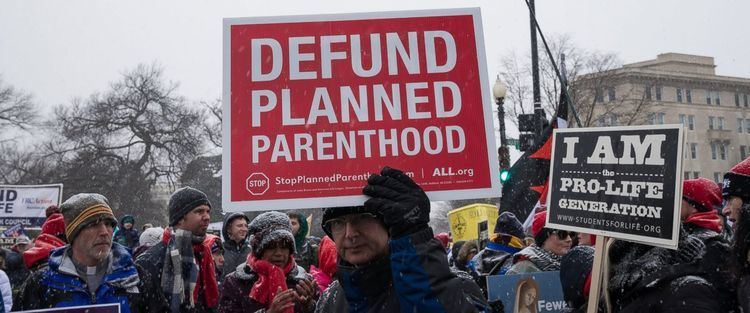
During the 2009 March for Life, the threat of passage by the 111th United States Congress of the Freedom of Choice Act—a bill that would "codify Roe v. Wade" by declaring a fundamental right to abortion and lifting many restrictions on abortion—served as a key rallying point, because pro-lifers worried that the legislation would eliminate certain abortion restrictions like parental notification for minors and repeal the Partial-Birth Abortion Ban Act.
Itinerary
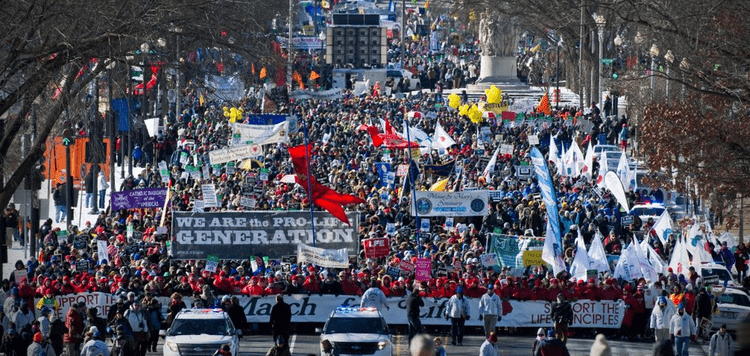
The March for Life proceedings begin around noon. They typically consist of a rally at the National Mall near Fourth Street. It is followed by a march which travels down Constitution Avenue NW, turns right at First Street and then ends on the steps of the Supreme Court of the United States, where another rally is held. Many protesters start the day by delivering roses and lobbying members of Congress.
Attendance
In 1987, approximately 10,000 participated, despite a snowstorm.
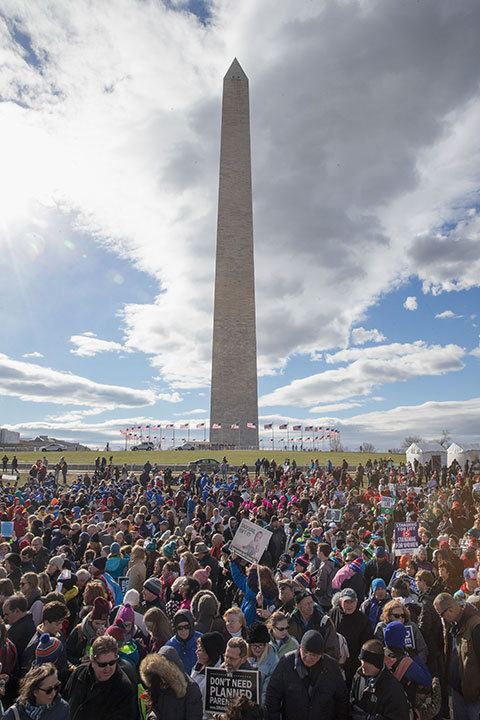
In 1995, which is the last year that the National Park Service made an official estimate of attendance, 45,000 attended, compared to 35,000 in 1994.
Between 2003 and 2012 the marches drew crowds estimated in the hundreds of thousands. In 2013, abortion opponents estimated the march drew 650,000. As with all large crowd estimates, the generated number of attendees reported differ, with sources indicating from thousands to tens of thousands.
In 2016, the march proceeded despite a blizzard that dropped 24 inches of snow in D.C., with attendees that "appeared to be in the thousands".
Many teenagers and college students attend the march each year, typically traveling with church/youth groups. A columnist for The Washington Post estimated that about half of the marchers are under age 30.
Notable speakers
In 1987, Ronald Reagan spoke remotely via telephone, and vowed to help “end this national tragedy". Jesse Helms, then Senator of North Carolina, attended and spoke. He called abortion an “American holocaust".
In 2003, George W. Bush spoke remotely via telephone and thanked participants for their “devotion to such a noble cause”. During his telephone addresses, he tended to speak broadly of opposing abortion as opposed to offering any specific efforts being made to overturn the Roe v. Wade decision.
In 2003, speakers included Representative Chris Smith, Republican of New Jersey, and Randall Terry, the founder of Operation Rescue. In his speech, Terry targeted the youth in the audience, calling them to “fight for all you're worth."
In 2004, 15 lawmakers, all Republican, spoke. Many of them stressed the importance of backing and voting for only candidates whose platform supported antiabortion in the November elections. Among the lawmakers who spoke were Representatives Todd Tiahrt of Kansas, and Patrick J. Toomey of Pennsylvania. Tiahrt, who also spoke at the 30th annual march, urged marchers to “help pro-lifers in your state”; Toomey supported these remarks, saying to vote for pro-life candidates in order to reclaim the Senate and, in turn, the courts.
In 2006, Representative Steve Chabot, an Ohio Republican and prominent pro-life advocate in the United States House of Representatives, spoke to the masses on overturning Roe v. Wade. He stated that the killing of millions of babies should be "sufficient justification for overruling that awful case". Nellie Gray, the founder of March for Life, spoke of "feminist abortionists", foretelling that the United States would hold them accountable for their actions in trials equivalent to the Nuremberg trials.
In 2009, approximately 20 Congress members spoke, including Representative F. James Sensenbrenner, Jr., Wisconsin Republican and former chairman of the House Judiciary Committee, and Gray.
In 2011, speakers included House Majority Leader Eric Cantor, House Majority Whip Kevin McCarthy, and several other members of Congress, including Mike Pence (see below).
In 2013, presenters included Speaker of the United States House of Representatives John Boehner (via a pre-recorded video address), former United States Senator and candidate for the 2012 Republican Party presidential nomination Rick Santorum, as well as other members of Congress.
In 2016, Republican Presidential candidate Carly Fiorina took part in the march.
In 2017, the march included Vice President Mike Pence; Kellyanne Conway, the Counselor to President Donald Trump; the Archbishop of New York Cardinal Timothy M. Dolan; pro-life activist Abby Johnson; NFL player Benjamin Watson; Virginia gubernatorial candidate Corey Stewart; and Mexican telenovela actress Karyme Lozano as speakers. Vice President Pence attended and spoke at the march, becoming the first vice president and the highest-ranking official to do so. Pence was also one of the speakers at the 2010 march while serving as representative of Indiana's 6th congressional district.
Media attention
The March for Life has received relatively little media attention over the years. The typical coverage consists of a “story with a tiny little comment from one individual marcher”, Gray has said.
To counter the relative lack of media coverage, one of the March for Life's supporters, the Family Research Council, organized a “Blogs for Life” conference in Washington, D.C. The main goal of the conference was to “bring pro-life bloggers together to talk over strategies” for securing more effective media coverage and advancing pro-life issues. Such strategies include securing media coverage through legislative means or by tapping into new media outlets.
EWTN, a Catholic radio and television network, has covered the march extensively in past years.
The 2017 Women's March in Washington, D.C. was used to illustrate the lack of media coverage for the March for Life — the crowds attending each march, held six days apart, were comparable, but according to a study by the Media Research Center, the 2017 Women's March received 129 times more coverage on major television networks ABC, CBS, and NBC during their morning and evening newscasts. The 2017 Women's March received 75 minutes of coverage between the networks while the March for Life received just 35 seconds.
Associated events
Various pro-life organizations hold events before and after the March. Such events include a Luau for Life at Georgetown University and a candlelight vigil at the Supreme Court. Additionally, independent films with a pro-life message have premiered or have been promoted in association with the March, including the Vatican endorsed film Doonby, which was shown at Landmark E Street Cinema during the 2013 march, and 22 Weeks, which premiered at Union Station’s Phoenix Theatre on the eve of the 2009 march. Students for Life of America typically holds its national conference the day after the March.
Anglican events
Anglicans for Life, the pro-life apostolate of the Anglican Church in North America, launched the "Mobilizing the Church for Life" conference on the day before the 2016 March for Life. On the following day, the primate of the Anglican Church in North America, Foley Beach, led Anglicans in the March for Life.
Catholic events
Preceding the March for Life, there are several Masses; two of which are celebrated at the Basilica of the National Shrine of the Immaculate Conception as well as the Verizon Center in Chinatown. The Catholic Archdiocese of Washington hosts a Youth Rally and Mass every year at the Verizon Center, attended by approximately 20,000 young people, where a message from the Pope is relayed.
In 2009, the apostolic nuncio to the United States, Archbishop Pietro Sambri, read Pope Benedict XVI's message, which told attendants that he was “deeply grateful” for the youths' "outstanding annual witness for the gospel of life". In 2008, the Pope's message thanked attendants for “promoting respect for the dignity and inalienable rights of every human being.” In 2011, an event parallel to the Verizon Center event was held at the D.C. Armory; a total of over 27,000 young people attended the events.
In response to a growing number of pilgrims traveling to the area for the March for Life, in 2009 the Roman Catholic Diocese of Arlington began to host the “Life is VERY Good” Evening of Prayer, the night before the March. In 2013, a Morning Mass and Rally (preceding the March for Life) was added and held at the Patriot Center on the campus of George Mason University, including Arlington Bishop Paul Loverde and more than 100 bishops and priests from across the nation. Life is VERY Good, which began with 350 participants in 2009, gathered in excess of 12,000 between its two events, held before and after the March, in 2013.
Since 2000, Catholic students at Georgetown University have hosted the annual Cardinal O'Connor Conference on Life the day after the march. It is the largest of the student-run pro-life conferences in the U.S., and it regularly hosts prominent pro-life speakers such as Cardinal O'Malley and feminist Helen Alvaré. Hundreds of laypeople and clergy attend each year to hear the speakers and to participate in break-out sessions on pro-life issues.
Eastern Orthodox events
The Orthodox presence at the March for Life is a long one with representation from many jurisdictions every year. The evening before the March, there is often at least one Vespers service at a local D.C. church. During the March there is a Panakhida for the Unborn performed along the way. Seminarians from Christ the Saviour Seminary, Holy Cross Seminary, St. Tikhon's Orthodox Seminary, and St. Vladimir's Orthodox Seminary (represented by the St. Ambrose Society) are invariably in attendance along with their families, hierarchs, clergy, and monastics from all over the country. Metropolitan Jonah of Washington (Orthodox Church in America) has been a speaker at the pre-March invocations in recent years. The Carpatho-Russian Diocese and Greek Archdiocese also have a strong connection to the March for Life and have been at the forefront of the pro-life movement. Metropolitan Nicholas of Amissos (American Carpatho-Russian Orthodox Diocese) was a constant presence during his episcopate dating back to 1987.
Evangelical events
At the 2016 March for Life rally, the Ethics & Religious Liberty Commission, the public policy arm of the Southern Baptist Convention, organized a conference "aimed at increasing the level of engagement in the pro-life cause".
The Taskforce of United Methodists on Abortion and Sexuality, which is a part of the National Pro-Life Religious Council, holds its annual service of worship at the United Methodist Building, and the liturgy held for the 2016 March of Life featured "a sermon by Dr. Thomas C. Oden, General Editor of the Ancient Christian Commentary on Scripture, former Professor of Theology and Ethics at Drew University, and Lifewatch Advisory Board member."
Lutheran events
Several Lutheran denominations, including the Lutheran Church-Missouri Synod, North American Lutheran Church and Wisconsin Evangelical Lutheran Synod, have held conferences in Washington D.C. surrounding the March of Life and the Lutheran Church-Missouri Synod (LCMS) is planning the 2017 LCMS Life Conference to be held on January 27, 2017, on the day of the March for Life. Students from schools affiliated with the Lutheran church bodies mentioned above have made pilgrimages to the capitol of the United States in order to march in the event. Before the 2016 March for Life, a Divine Service was celebrated at Immanuel Lutheran Church in Alexandria, Virginia.
Virtual March for Life
In 2010, Americans United for Life launched an online virtual March. Pro-lifers unable to attend the event in person could create avatars of themselves and take part in a virtual demonstration on a Google Maps version of the National Mall. The online event attracted approximately 75,000 participants.
